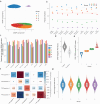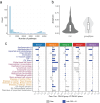Distinct genetic liability profiles define clinically relevant patient strata across common diseases
- PMID: 38951512
- PMCID: PMC11217418
- DOI: 10.1038/s41467-024-49338-2
Distinct genetic liability profiles define clinically relevant patient strata across common diseases
Abstract
Stratified medicine holds great promise to tailor treatment to the needs of individual patients. While genetics holds great potential to aid patient stratification, it remains a major challenge to operationalize complex genetic risk factor profiles to deconstruct clinical heterogeneity. Contemporary approaches to this problem rely on polygenic risk scores (PRS), which provide only limited clinical utility and lack a clear biological foundation. To overcome these limitations, we develop the CASTom-iGEx approach to stratify individuals based on the aggregated impact of their genetic risk factor profiles on tissue specific gene expression levels. The paradigmatic application of this approach to coronary artery disease or schizophrenia patient cohorts identified diverse strata or biotypes. These biotypes are characterized by distinct endophenotype profiles as well as clinical parameters and are fundamentally distinct from PRS based groupings. In stark contrast to the latter, the CASTom-iGEx strategy discovers biologically meaningful and clinically actionable patient subgroups, where complex genetic liabilities are not randomly distributed across individuals but rather converge onto distinct disease relevant biological processes. These results support the notion of different patient biotypes characterized by partially distinct pathomechanisms. Thus, the universally applicable approach presented here has the potential to constitute an important component of future personalized medicine paradigms.
© 2024. The Author(s).
Conflict of interest statement
F.I. receives funding from Open Targets, a public-private initiative involving academia and industry, and performs consultancy for the joint AstraZeneca-CRUK functional genomics center and for Mosaic Therapeutics. TFMA is a salaried employee of Boehringer Ingelheim Pharma outside the submitted work. The remaining authors declare no competing interests.
Figures







Update of
-
Distinct genetic liability profiles define clinically relevant patient strata across common diseases.medRxiv [Preprint]. 2023 May 11:2023.05.10.23289788. doi: 10.1101/2023.05.10.23289788. medRxiv. 2023. Update in: Nat Commun. 2024 Jul 1;15(1):5534. doi: 10.1038/s41467-024-49338-2. PMID: 37214898 Free PMC article. Updated. Preprint.
References
-
- Disease GBD, Injury I, Prevalence C. Global, regional, and national incidence, prevalence, and years lived with disability for 354 diseases and injuries for 195 countries and territories, 1990-2017: a systematic analysis for the Global Burden of Disease Study 2017. Lancet. 2018;392:1789–1858. doi: 10.1016/S0140-6736(18)32279-7. - DOI - PMC - PubMed
MeSH terms
Grants and funding
- SCHU 1603/4-1, 5-1, 7-1; FA241/16-1/Deutsche Forschungsgemeinschaft (German Research Foundation)
- R01 MH109897/MH/NIMH NIH HHS/United States
- 031L0174A/Bundesministerium für Bildung und Forschung (Federal Ministry of Education and Research)
- R01 MH075916/MH/NIMH NIH HHS/United States
- DP3 DK111898/DK/NIDDK NIH HHS/United States
- U01 MH103392/MH/NIMH NIH HHS/United States
- R01 MH109677/MH/NIMH NIH HHS/United States
- SFB TRR 267 (B05)./Deutsche Forschungsgemeinschaft (German Research Foundation)
- R01 MH124873/MH/NIMH NIH HHS/United States
- HHSN271201300031C/DA/NIDA NIH HHS/United States
- 01EW 2005/Bundesministerium für Bildung und Forschung (Federal Ministry of Education and Research)
- P50 MH066392/MH/NIMH NIH HHS/United States
- R01 MH080405/MH/NIMH NIH HHS/United States
- R01 MH085542/MH/NIMH NIH HHS/United States
- SFB 1123 (B02)/Deutsche Forschungsgemeinschaft (German Research Foundation)
- 031L0174B/Bundesministerium für Bildung und Forschung (Federal Ministry of Education and Research)
- 01EE1404H/Bundesministerium für Bildung und Forschung (Federal Ministry of Education and Research)
- 01ZX1706/Bundesministerium für Bildung und Forschung (Federal Ministry of Education and Research)
- ZF4590201BA8/Bundesministerium für Wirtschaft und Energie (Federal Ministry for Economic Affairs and Energy)
- R37 MH057881/MH/NIMH NIH HHS/United States
- 01ZX1504/Bundesministerium für Bildung und Forschung (Federal Ministry of Education and Research)
- 01ZX1614K/Bundesministerium für Bildung und Forschung (Federal Ministry of Education and Research)
- 01ZX1904A/Bundesministerium für Bildung und Forschung (Federal Ministry of Education and Research)
- P50 MH084053/MH/NIMH NIH HHS/United States
- R01 MH097276/MH/NIMH NIH HHS/United States
- P01 AG002219/AG/NIA NIH HHS/United States
- R01 MH093725/MH/NIMH NIH HHS/United States
- P50 AG005138/AG/NIA NIH HHS/United States
- 81X2600522/British Heart Foundation (BHF)
- 01EW 2009/Bundesministerium für Bildung und Forschung (Federal Ministry of Education and Research)
- NARSAD Young Investigator Grant/Brain and Behavior Research Foundation (Brain & Behavior Research Foundation)
- R01 MH110921/MH/NIMH NIH HHS/United States

